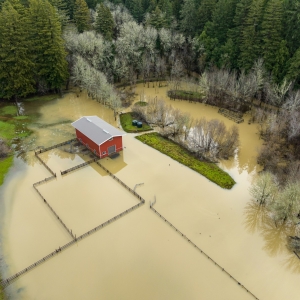The Stream, July 5, 2023: ‘Weird’ Drought Spurs Water Conservation and Stunts Crops in U.S. Corn Belt

Fall harvest in Nebraska. Photo J. Carl Ganter/Circle of Blue
YOUR GLOBAL RUNDOWN
- A massive fish die-off in southeastern Iraq is the latest worry for the country’s riparian habitats, which face low flows and drought.
- The United Nations is expected to approve a plan for Japan to release 1.3 million tons of treated radioactive water into the Pacific Ocean.
- A widespread drought throughout the U.S. Midwest has made growing seasons more challenging and expensive.
- Faulty infrastructure in Havana, Cuba, has left at least 10 percent of the capital’s residents without access to water.
A new study of FEMA’s flood buyout program suggests it reduces risk yet deepens “white flight” out of American neighborhoods.
“The policy lesson is really that it’s not just the environmental risk and the way the policy works that’s intervening to affect how it plays out for homeowners. We need to engage communities more proactively and think about not only when they retreat, but how they retreat.” — Jim Elliott, professor at Rice University and lead author of the study.
Grist reports on a new study that analyzed the Federal Emergency Management Agency’s flood buyout program, which has spent billions of dollars over the past three decades to purchase and tear down flood-prone properties. Homeowners then moved elsewhere.
The study found that while “those participants actually do seek new homes with substantially lower flood exposure,” the racial makeup of the floodplain neighborhoods left behind, and the areas those homeowners are moving to, are homogenizing.
— Christian Thorsberg, Interim Stream Editor
Recent WaterNews from Circle of Blue
- Will Michigan’s Largest Water Provider Target Tiny City For Next Shutoffs? — Residents of Highland Park face $24 million in delinquent water bills.
- Failing Rains in Darfur Foster Conflict and Displacement — Graphic Journalism.
The Lead
Nearly 60 percent of the U.S. Midwest — including Illinois, Indiana, Iowa, Kentucky, Michigan, Minnesota, Missouri, Ohio and Wisconsin — has experienced moderate drought this spring; 93 percent of the region is “abnormally dry,” with 16 percent experiencing “severe drought,” Stateline reports.
In agricultural counties, especially in states such as Kansas and Nebraska, the lack of rain has had significant effects. Farmers have been forced to buy more feed for their livestock, rather than rely on grazing. Soil is losing moisture, impacting both present and future yields. Wheat, soybean, and corn crops are browning, unsustained.
The lack of rain has not yet been attributed to climate change, climatologists say. Though with the return of El Niño, a lack of precipitation in the Midwest is particularly “weird.”
This Week’s Top Water Stories, Told In Numbers
35
Percent flow of the Tigris River, one of ancient Mesopotamia’s “two great rivers,” compared to its 100-year average. Iraq, one of the world’s most vulnerable countries to climate change according to the United Nations, continues to see its riparian habitat battered — this past week, thousands of dead fish washed up on the shores of the Amshan River, which draws its waters from the Tigris, Al Jazeera reports. Officials found elevated salinity levels and no oxygen in the river water, deeming it unsuitable for farmers and raising concerns that the surrounding vegetation and historic marshes may also suffer.
100,000
Estimated number of Havana residents — up to as many as 200,000 — currently without water access as shortages take hold in Cuba’s capital, Reuters reports. Officials are blaming “faulty motorized pump stations, leaky pipes, and climate change-induced drought” for the scarcity, saying that past energy failures, which led to rolling blackouts, are not in play this year. Nearly two dozen motorized water pumps are currently being installed around the city, which continues to experience summer heatwaves.
On the Radar
Al Jazeera reports that the United Nations is expected to approve plans for Japan’s Fukushima Daiichi power plant “to release millions of tonnes of treated radioactive water” into the Pacific Ocean. More than 1.33 million cubic meters of water, “enough to fill 500 Olympic-sized swimming pools,” have accumulated since the power plant’s 2011 nuclear disaster. Some of the water was used to cool the site’s three damaged nuclear reactors, while the rest includes contaminated rain and groundwater that have been collected in the years since. Removal of the water, which is stored in tanks now nearing capacity, is also necessary “so the wrecked plant can be decommissioned.” Opponents of the decision include fishing groups, environmental activists, South Korea, China, and many Pacific island nations.
More Water News
Shorelines, sewer lines: Coastal erosion and rising sea levels are threatening American Samoa’s water, power, and sewer lines, which run underground near the shores, Yale Climate Connections reports.
Buzuruna Juzuruna: An organic seed farm in Lebanon is exposing new and old local farmers to well-practiced, water-saving agro-ecological methods, Mongabay reports.
Christian Thorsberg is an environmental writer from Chicago. He is passionate about climate and cultural phenomena that often appear slow or invisible, and he examines these themes in his journalism, poetry, and fiction.






Leave a Reply
Want to join the discussion?Feel free to contribute!